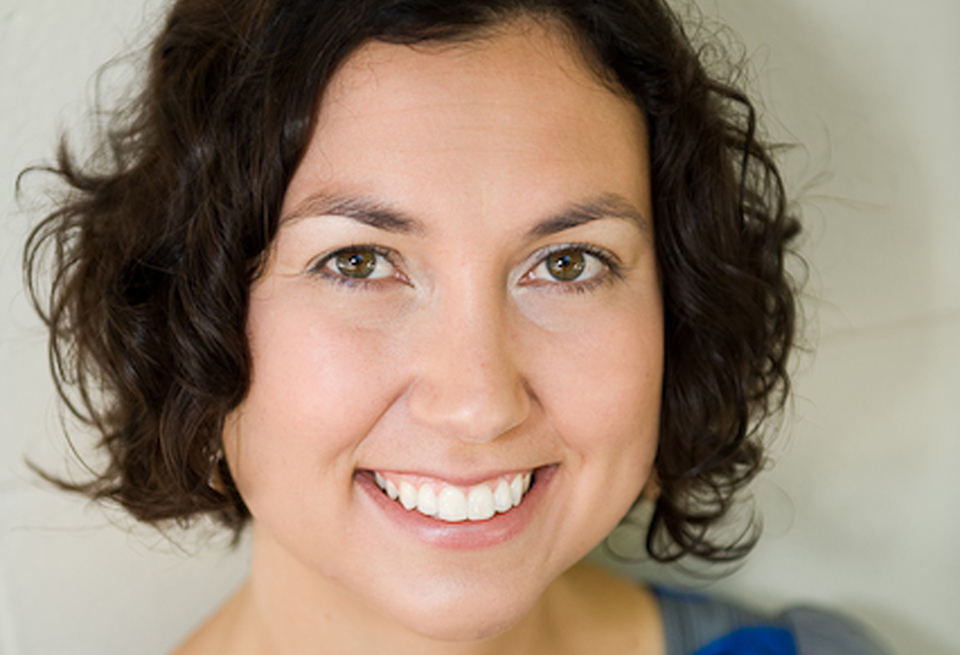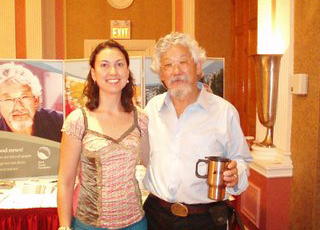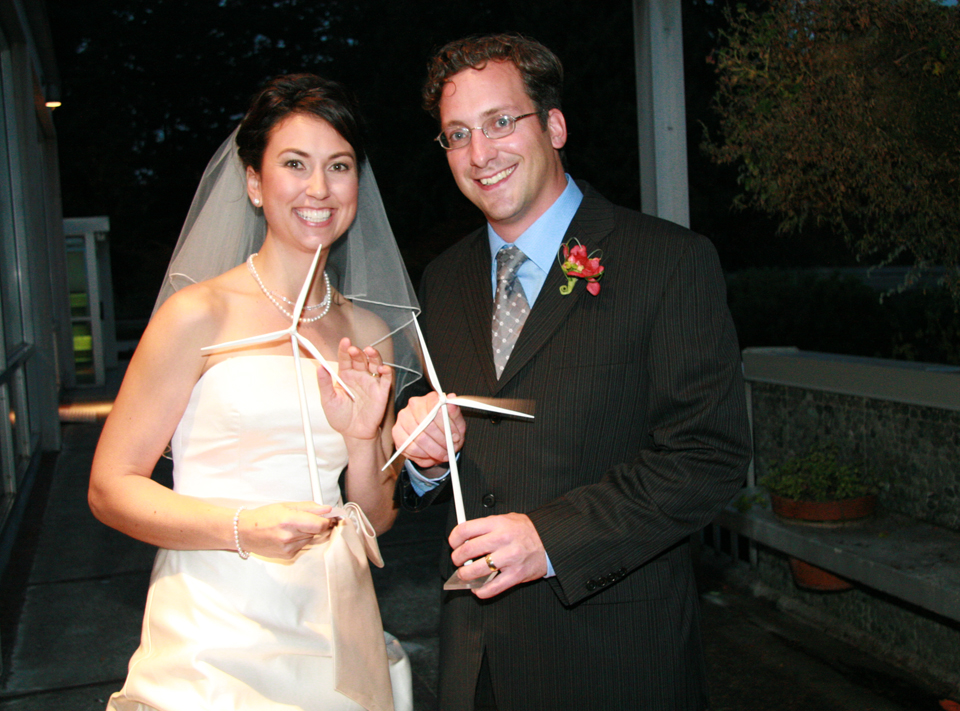Lindsay Coulter, David Suzuki’s Queen of Green (2008–2020)
Hear the latest podcast with this Kickass CanadianRecorded: October 15, 2015
“I truly believe that kids who grow up in nature grow up into adults who care about protecting it.”

Like many Canadians of her generation, Lindsay Coulter grew up watching David Suzuki’s television series The Nature of Things. She also grew up wading through creeks and adventuring through forests on her grandparents’ farm near Edmonton, Alberta, chasing after frogs and generally loving “all domesticated and wild critters” alike.
Not surprisingly, young Lindsay started to think she might like to become a veterinarian one day. After discovering that part of the job would require putting animals down, she nixed the idea. Still, she loved animals and everything nature had to offer, from fresh air to wild open spaces. So when her aunt asked what she might like to be when she grew up, Lindsay answered, without thinking, “One day, David Suzuki and I are going to be like this,” and held up two tightly crossed fingers.
“At the time, the David Suzuki Foundation didn’t even exist,” she says. “And I didn’t know what he did for a living, exactly. I just knew he loved animals and wanted to save the planet, and so did I.”
Fast forward more than two decades, and Lindsay is living the dream. After joining the David Suzuki Foundation in 2006, she quickly became an essential part of the organization. Just weeks after accepting an entry-level position at the Vancouver office, she was recruited to accompany David on a cross-country tour promoting his autobiography. It was clear the pair was a match made in green heaven.

Lindsay and David Suzuki on his cross-country tour, 2006
Before long, she slipped into her role as David Suzuki’s Queen of Green, providing tips and advice on how to live in a more sustainable and environmentally friendly manner. She shot how-to videos from her kitchen, demonstrating simple ways to make everything from nontoxic liquid laundry soap to a bee-friendly garden, and explaining how to be a smarter recycler.
When the Foundation revamped its new website in 2009, she had the perfect platform to launch her Queen of Green blog, a place from which she could “answer fan questions about everyday green living, and offer up tips and recipes.” Not only does her blog provide a forum for the latest green trends and happenings, it’s also an invaluable resource for a range of sustainable living issues, and gives fans a place to pose questions and share what they’re doing to go green.
Lindsay now works full-time as the Queen of Green, writing her weekly blog on the David Suzuki Foundation website. She’s also a syndicated columnist, writing a weekly column every Monday in the Metro News, a free national newspaper. I was put in touch with the busy lady when I approached the David Suzuki Foundation about featuring one of their staff on KickassCanadians.ca, and had the privilege of hearing firsthand how she blossomed into her current role.
A natural fit
Today, Lindsay and her fellow Kickass Canadian David Suzuki really are like this (fingers crossed). But it happened of its own accord. She never set about actively pursuing a career with her idol, either through her educational or career paths. Like many things that are meant to be, it just kind of happened.

Lindsay and David Suzuki, Vancouver, B.C., 2011
Knowing she had an interest in animals, Lindsay enrolled in the zoology program at the University of Alberta. It didn’t take long to realize she’d made the right choice. “In my first zoology class, I knew that was it; that’s what I wanted to do,” she says.
Lindsay made the most of her education, taking a wide range of courses to determine what she liked best: ecology, mammology, ornithology and paleontology. She found related work during the summers, starting as an assistant to a graduate student who was studying the impacts of logging on fur-bearers. “In total, I spent five summers dodging bears and living out of a tent in northern Alberta’s boreal forest,” she says. “I was catching weasels and ear tagging and radio-collaring them, and following their activities at night. That’s how I became known as the ‘weasel woman.’ The smell is as bad as you might imagine!”
She loved being outside and doing hands-on work with wildlife. But after awhile, the weight of what she was seeing started to get heavy. “It got really depressing after sitting in many a clearcut and seeing all the oil and gas activities, and also seeing pristine old-growth forests and knowing they would be slated for logging,” she says. “I thought, ‘There has to be a better way.’ I wondered, ‘How do I tell my parents about this? How do I get people in the city to care?’ Because if they saw the real impact of our consumption, they’d probably change the way they did things.”
Spreading the word
It was that train of thought that revealed to Lindsay her true calling. As much as she loved the data collection and scientific aspects of zoology, she was more interested in finding a way to communicate to everyday Canadians what she had learned, without dragging them out into the bush.
After graduating university in 1999, she spent one summer working for Parks Canada as an interpreter at Elk Island National Park in Alberta. It was her first taste of spreading the word about nature and science to the public, and she found it went down very well. “I love natural history, and showing people how to identify animal prints or how to identify birds by their song,” she says.
Lindsay went on to spend four years as the “owl lady” for the Alberta Fish & Game Association (AFGA), helping farmers and ranchers identify sustainable ways of managing their land that would enable them to make a living while protecting endangered species. “In an effort to help keep owls around on the landscape, I was getting farmers and ranchers to count their endangered burrowing owls and record them, to graze their cattle at certain times, not spray for grasshoppers, not kill badgers and not kill all of the gophers,” she says.
She didn’t know it at the time, but the opportunity to communicate directly with people who were trying to find a balance between meeting life’s demands and protecting the environment provided the perfect training for her next job—as David Suzuki’s grassroots spokesperson and role model for sustainable living. Having the “gift of gab,” as she calls it, didn’t hurt either.
Queen of Green
It was passion for a person, rather than for nature, that brought Lindsay to the David Suzuki Foundation. In 2006, she left her job and followed her now-husband Steven Coulter to Vancouver. Finally in the same city as her childhood hero, she “applied for every job under the sun” at the Foundation, and the rest is her story.
Landing in Vancouver turned out to be just the boost she needed to be worthy of her future coronation. “Although I really loved nature and the environment when I lived in Alberta, I definitely wasn’t the Queen of Green,” she says. “I’ve found it’s a lot easier to be green here in Vancouver because it’s one of the most sustainable cities in North America.”
The combination of living in the bike-friendly metropolis that gave rise to Greenpeace, living in a walkable neighbourhood, and being “bombarded by environmental issues” on a daily basis at the David Suzuki Foundation, provided an unparalleled learning experience for the future Queen of Green. Once her eyes were opened wide, there was no going back.
When Lindsay and Steven married in 2006, she went to great lengths to hold a green wedding. “That was before anyone was using the term ‘green wedding,’” she says. “I was known to my florist and caterer as ‘That girl doing that thing.’” And that was just the beginning. She traded in the toxic lotions, soaps, scented laundry detergent and air fresheners she used in Edmonton, for scent-free alternatives and homemade cleaning products. From her new Vancouver digs, she could walk to work, and easily buy organic, local and seasonal food.

The Coulters at their green wedding; photo by Chloe Stockdale
Today, Lindsay has kept up those habits and then some. She’s currently in the midst of a green bathroom reno. “It’s definitely been a journey,” she says. “There’s always more to learn.”
A simple formula
Since becoming the Queen of Green in 2008, Lindsay has been a beacon for Canadians looking to go greener.
In late 2010, she turned her focus to one family in particular: the Smiths of Edmonton. Canadian Living magazine invited its readers to submit a pitch to win a lifestyle makeover from Lindsay. The selected entry was from Melanie Smith, a wife and mother of four kids under the age of seven. As cited on Lindsay’s blog, Melanie wrote, “Since we’re a big family, we live large: big house, big vehicles, big trips to the grocery store. We generally just use a lot of stuff. Our footprint is huge and we need to change it.”
The Smiths were unsure of what to expect when the Queen of Green arrived at their home. But rather than commanding them to sell their cars and install solar panels, Lindsay started by looking at what the family was already doing and helped them take it a bit further.
Following her simple five-step formula, she showed the Smiths several small changes they could make to their daily lives that would significantly reduce their environmental footprint. “I tried to suggest changes that aligned with their values,” she says. “They were already washing their clothes using cold water, so I challenged them to use nontoxic laundry soap, and hang their clothes to dry. They were recycling a lot; they were very conscientious about that. So I challenged them to recycle less by reducing the amount of packaging they brought into the home in the first place, and reuse as much as possible. There is a hierarchy to the three Rs, and recycling is the last in line. It still takes resources to have recyclables picked up and broken down.”
The last step in her formula is to “pay it forward.” Once the Smiths figured out how to make their lifestyle even greener, Lindsay encouraged them to pass on their knowledge to others in the community. “If you’ve mastered composting and have an amazing garden in your backyard, why not find out if your neighbours or local youth groups want to participate?” she says. “We’re all on this sustainability journey together, learning from each other.”
Taking action
As much as Lindsay emphasizes the importance of making changes in our homes and our daily lives, she points out that individual actions will only go so far; at some point, collective action must be taken. The David Suzuki Foundation plays a big role in facilitating collective changes. In addition to promoting individual actions we can take—such as those listed under ‘Top 10 ways you can stop climate change’—the Foundation works hard to effect changes to policy and legislation in an effort to protect and conserve the environment. But Lindsay wants Canadians to understand that we all have a role to play in bringing about collective change.
“People need to empower themselves and realize that they have a voice,” she says. “They don’t necessarily need David Suzuki to write to their city or show up at their school. I want them to realize that we all have a lot of power, whether it’s writing to a company or going out to vote to make your voice heard. It’s great that we all act individually by making smarter, greener choices, but it’s not just about shopping our way out of this. We’re not just consumers; we’re part of communities and families and neighbourhoods, and we need to start making a difference collectively.”
Go play
There’s another thing Lindsay hopes Canadians will start doing more of: getting outside. From our National Parks, which she refers to as a legacy, to the urban green space just beyond our front doors, the environment is everywhere and it’s there to be enjoyed and celebrated. The David Suzuki Foundation is committed to protecting our environment so that nature is protected for future generations. But that doesn’t mean we shouldn’t start enjoying it today.
As Lindsay sees it, the more contact we have with nature, the brighter our collective future will be. “David Suzuki embraced nature as a child, and spent his youth in a swamp and exploring the outdoors,” she says. “He was never told it was dirty or yucky, or not to bring salamander eggs into the home. And he’s become one of the world’s greatest advocates for conservation. I truly believe that kids who grow up in nature grow up into adults who care about protecting it.”
* * *
For the latest on Lindsay, ‘Like’ her Facebook page, follow @DavidSuzukiQoG on Twitter or visit her Queen of Green blog.
 Kickass Canadians
Kickass Canadians
I had the opportunity to work with Lindsay as a volunteer at DSF. Not only is she a warm and personable person, she is encouraging and truly an inspirational lady. She is most definitely a Kickass Canadian!
Thanks for the kind words, Veronica!
Lindsay is a warm, funny, humble woman and I feel honoured to know her. You totally kick ass Linds!
I found your laundry soap recipe online as I had purchased a twin-tub washer (since returned because it leaked constantly). I grew up with a wringer-washer and the twin tub was my answer to using less water for laundry and until the leaks, it worked beautifully! I then found the laundry soap recipe as I wanted to get rid of my husband’s 1950’s style chemical addiction. My son and I have toxic-sensitive skin and well, the laundry soap cleans better than even the most green commercial laundry soap, so I make it all the time. I had been making my own spray cleaners for a while, but after the soap, I tossed EVERYTHING and made two cleaners – one for the bathroom using simple aluminum-free baking soda and one for the surfaces and floors. The windows, we use a chamis and water. Ever since I completely detoxed the house (including beauty products – they’re all gone too which means no makeup), I haven’t used my asthma medication in over a month and it’s allergy season! No one can believe it and now, everyone is asking me how to detox the house including one person who has a rare blood disorder and the other has thyroid cancer. They looked up ingredients online and were scared. Each person filled two green (no pun intended) garbage bags with toxins and I told them take the bags to the hazardous waste depot a the landfill site for disposal. I believe that if we can show more people that their bodies are toxed-out and can’t take one more toxin, more and more people will feel better and may even reduce or cure their ailments.
Thank you for what you started.
Rhonda, how amazing that you’ve had such great results. Long live the Queen of Green! 😉